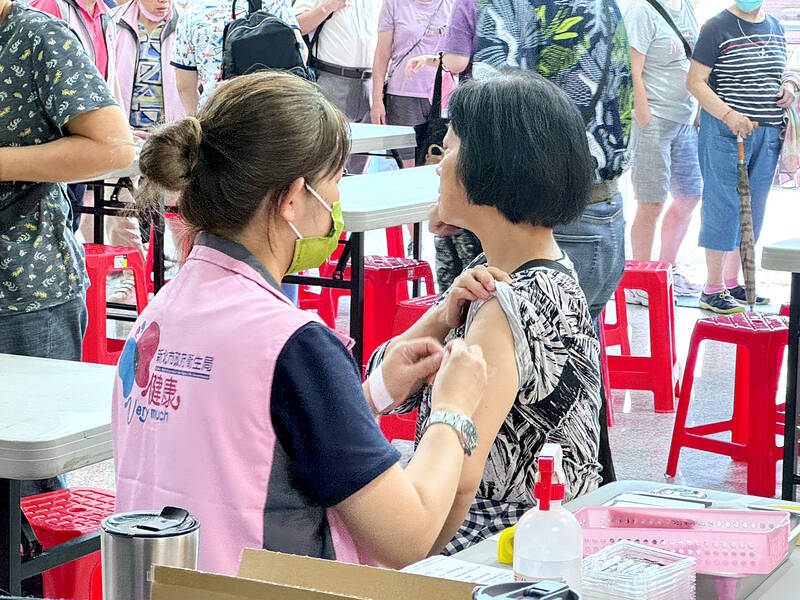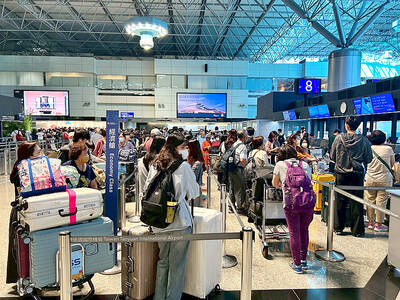The Centers for Disease Control (CDC) on Thursday announced that the required interval between two COVID-19 vaccine doses for high-risk groups would be shortened from six months to two months, effective from Wednesday next week.
After receiving numerous inquiries from high-risk people seeking a second dose of the JN.1 COVID-19 vaccine before the current 180-day interval ends, the CDC decided to accommodate such requests, the centers said in a news statement.
The shortened 60-day interval, introduced in consultation with the Ministry of Health and Welfare’s Advisory Committee on Immunization Practices, would allow three high-risk groups to “boost their immunity earlier” amid a rise in COVID-19 cases in Taiwan, the CDC said.

Photo: Lo Kuo-chia, Taipei Times
The three high-risk groups include people aged 65 or older, indigenous people aged 55 to 64, and those aged six months or older with weakened immune systems, it added.
About 760,000 people are expected to be eligible for a second jab from Wednesday next week, the date set to allow vaccination sites to complete preparations to accommodate the increased demand, it said.
People who are not in the high-risk groups are only eligible for one dose of the JN.1 COVID-19 vaccine under the publicly funded vaccination program.
The current 180-day interval for high-risk groups is considered a strict standard suitable for periods of low COVID-19 transmission, while the soon-to-be-implemented 60-day interval reflects a more flexible approach in response to rising case numbers, CDC Deputy Director-General Philip Lo (羅一鈞) said.
Citing studies on the XBB COVID-19 vaccine, Lo said that in people aged 65 or older, vaccine protection against COVID-19-related hospitalization is 53 percent within the first 59 days after one dose, dropping to 38 percent between days 60 and 119.
Protection from a single dose further declines to 19 percent between days 120 and 179, and to nearly zero beyond 180 days, he said.
Meanwhile, public demand for the JN.1 COVID-19 vaccines remains strong amid rising case numbers, the CDC said, adding that 69,000 people received the shot between from May 26 to Sunday last week — a 1.7-fold increase from 41,000 in the previous week, and the highest weekly total this year.

Three batches of banana sauce imported from the Philippines were intercepted at the border after they were found to contain the banned industrial dye Orange G, the Food and Drug Administration (FDA) said yesterday. From today through Sept. 2 next year, all seasoning sauces from the Philippines are to be subject to the FDA’s strictest border inspection, meaning 100 percent testing for illegal dyes before entry is allowed, it said in a statement. Orange G is an industrial coloring agent that is not permitted for food use in Taiwan or internationally, said Cheng Wei-chih (鄭維智), head of the FDA’s Northern Center for

The Chinese military has built landing bridge ships designed to expand its amphibious options for a potential assault on Taiwan, but their combat effectiveness is limited due to their high vulnerability, a defense expert said in an analysis published on Monday. Shen Ming-shih (沈明室), a research fellow at the Institute for National Defense and Security Research, said that the deployment of such vessels as part of the Chinese People’s Liberation Army (PLA) Navy’s East Sea Fleet signals a strong focus on Taiwan. However, the ships are highly vulnerable to precision strikes, which means they could be destroyed before they achieve their intended

About 4.2 million tourist arrivals were recorded in the first half of this year, a 10 percent increase from the same period last year, the Tourism Administration said yesterday. The growth continues to be consistent, with the fourth quarter of this year expected to be the peak in Taiwan, the agency said, adding that it plans to promote Taiwan overseas via partnerships and major events. From January to June, 9.14 million international departures were recorded from Taiwan, an 11 percent increase from the same period last year, with 3.3 million headed for Japan, 1.52 million for China and 832,962 to South Korea,

REWRITING HISTORY: China has been advocating a ‘correct’ interpretation of the victory over Japan that brings the CCP’s contributions to the forefront, an expert said An elderly Chinese war veteran’s shin still bears the mark of a bullet wound he sustained when fighting the Japanese as a teenager, a year before the end of World War II. Eighty years on, Li Jinshui’s scar remains as testimony to the bravery of Chinese troops in a conflict that killed millions of their people. However, the story behind China’s overthrow of the brutal Japanese occupation is deeply contested. Historians broadly agree that credit for victory lies primarily with the Chinese Nationalist Party (KMT)-led Republic of China (ROC) Army. Its leader, Chiang Kai-shek (蔣介石), fled to Taiwan in 1949 after losing a